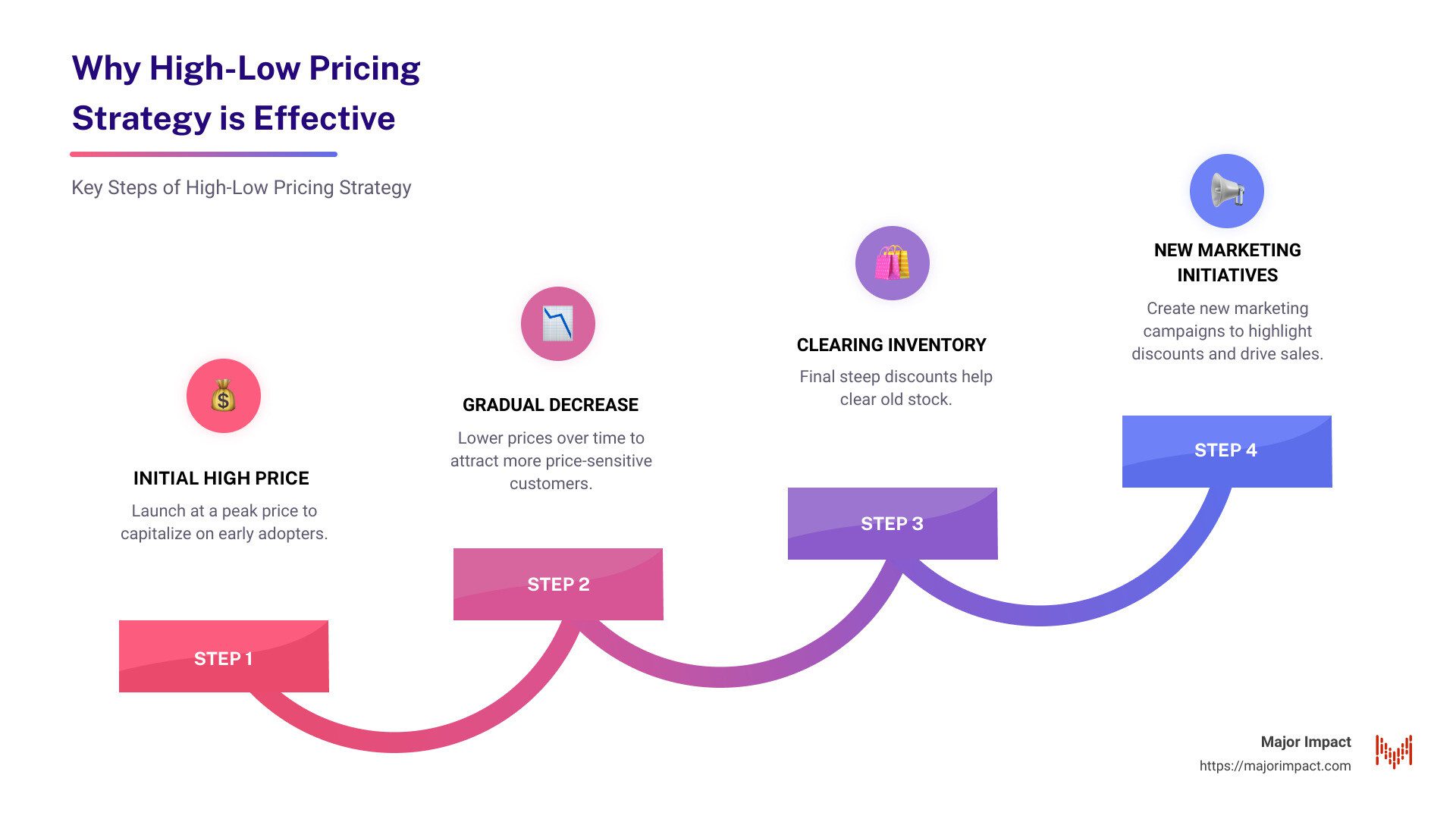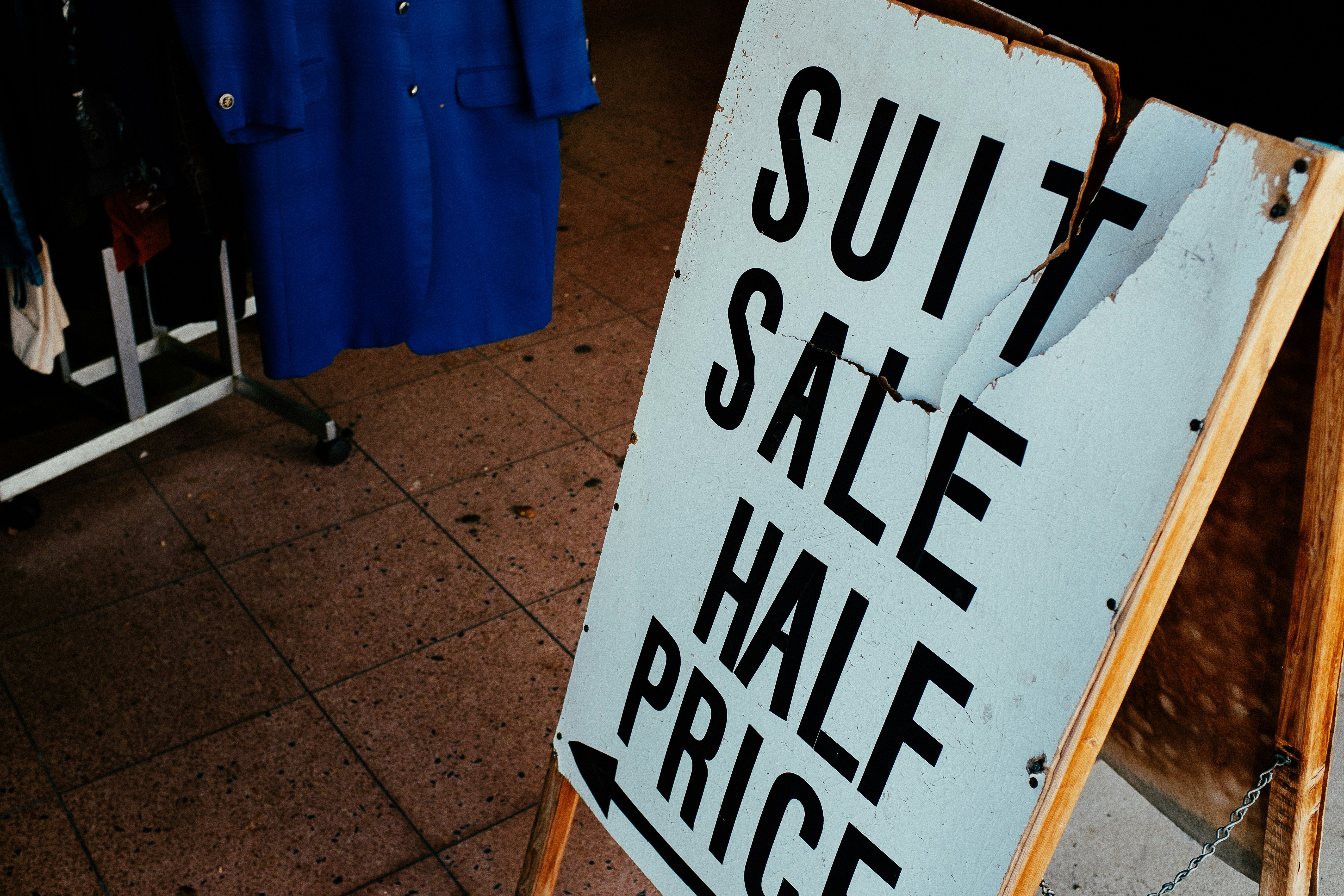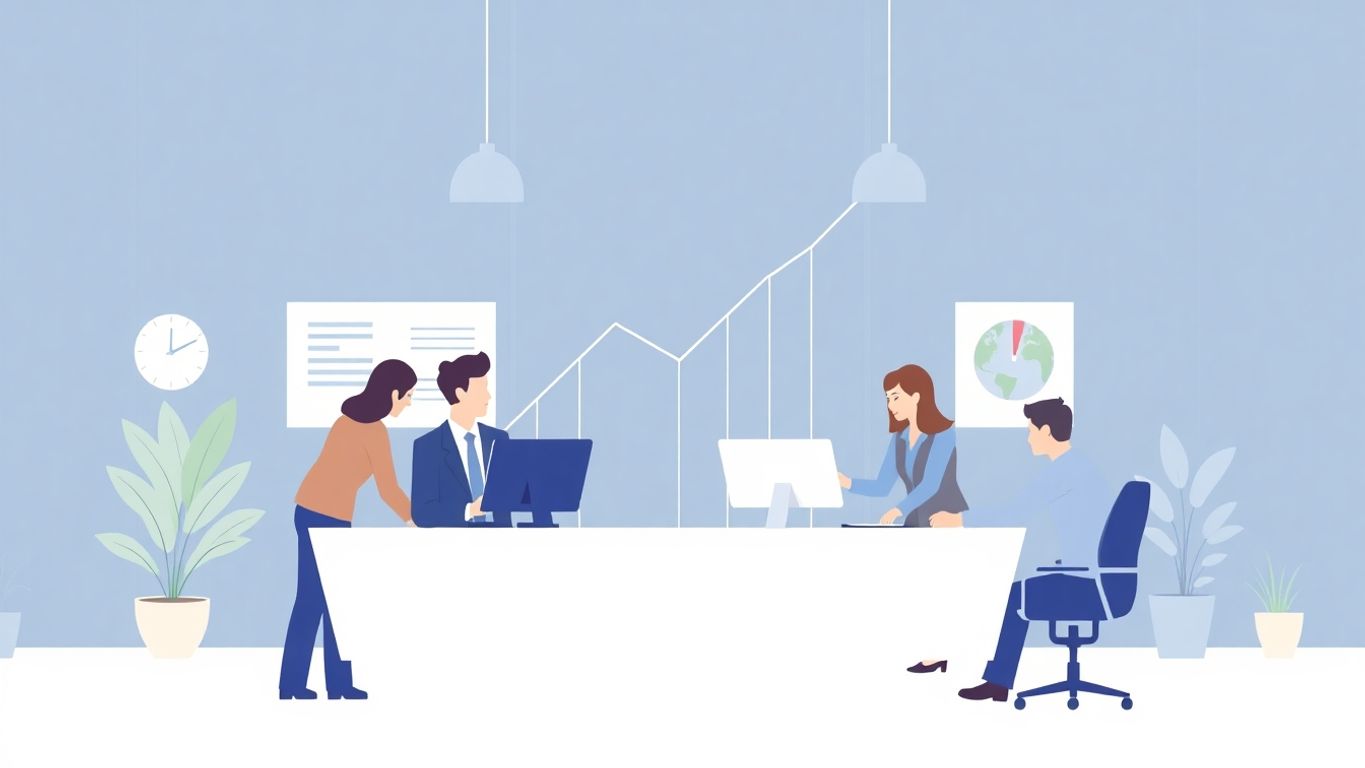Table of Contents
Why High-Low Pricing Strategy is Effective
When it comes to capturing consumer interest, the high low pricing strategy can be a game changer. This approach involves initially charging a high price for a product, then gradually lowering it as demand tapers off or new models are released. It’s a tactic many retailers use to balance profit margins with inventory turnover efficiently.
Quick Answer:
- Initial High Price: Launch at a peak price to capitalize on early adopters.
- Gradual Decrease: Lower prices over time to attract more price-sensitive customers.
- Clearing Inventory: Final steep discounts help clear old stock.
We’ll explore the ins and outs of this strategy, its benefits, and some challenges you might face.
I’m Elliott Kosmicki. I’ve spent over 20 years helping businesses use smart strategies like the high low pricing strategy to thrive in competitive markets.
What is High-Low Pricing Strategy?
The high-low pricing strategy is a retail approach where a product is initially priced high and later discounted over time. This method is also called “hi-lo” or “skimming” pricing.
Initial High Price
When a new product hits the market, it often carries a high price tag. This initial high price targets early adopters who are willing to pay a premium for being the first to own the latest gadget or fashion item. For example, when Apple releases a new iPhone, it comes with a high price point to attract tech enthusiasts who prioritize having the latest technology.
Subsequent Discounts
As the hype around the product begins to fade, retailers start to offer discounts. This attracts more price-sensitive customers who were waiting for a price drop. The idea is to capture different segments of the market over time. For instance, video game publishers often reduce the price of new games a few months after release, making them more affordable for a broader audience.
Clearance Sales
Finally, when the product is nearing the end of its lifecycle or season, retailers offer steep discounts to clear out remaining inventory. This is common in the fashion industry, where winter coats are heavily discounted as spring approaches. These final markdowns help free up space for new inventory.
Key Takeaways
- Initial High Price: Targets early adopters.
- Subsequent Discounts: Attracts price-sensitive customers.
- Clearance Sales: Clears old inventory.
The high-low pricing strategy is effective for maximizing profits and managing inventory. However, it’s important to know when and how to use it for the best results.
Pros of High-Low Pricing Strategy
Inventory Reduction
One of the biggest advantages of a high-low pricing strategy is its ability to reduce inventory. When products aren’t selling, lowering the price can make them more appealing. For instance, retailers often use this strategy to clear out seasonal items. As winter ends, stores slash prices on winter coats to make room for spring collections. This method helps businesses avoid overstock and keeps their inventory fresh.
New Marketing Incentive
A high-low pricing strategy also opens up new marketing opportunities. Initially, products are marketed as high-end or premium. Once demand slows, the focus shifts to the discount. Phrases like “Limited Time Offer” or “Get It While It Lasts” create urgency. This shift in marketing keeps the product in the spotlight and attracts different customer segments over time.
More Customers
Discounts attract more customers, both new and returning. When prices drop, people who were hesitant to buy at the original price are more likely to make a purchase. For example, a shopper who usually buys electronics from one store might be lured to another store offering a high-end TV at a discounted rate. This influx of new customers can lead to increased foot traffic and online visits.
Increased Sales
By offering a product at varying price points, businesses can capture a broader audience. Early adopters buy at the high price, while cost-conscious shoppers wait for discounts. This approach maximizes sales over the product’s lifecycle. For example, tech companies like Apple often see a surge in sales when they lower prices on older models after launching a new product. This strategy ensures a steady stream of revenue.
In summary, the high-low pricing strategy is an effective way to manage inventory, create marketing buzz, attract new customers, and boost sales. However, it’s important to weigh these benefits against potential downsides, which we’ll discuss next.
Cons of High-Low Pricing Strategy
Loss of Profit
A high-low pricing strategy can lead to decreased profit margins. When customers wait for prices to drop, retailers may lose the opportunity to sell at higher prices. For example, customers might only buy a TV when it’s on sale, leading to lower overall profits for the store. To minimize loss, retailers should use this strategy to draw customers in and encourage them to buy other items with higher margins.
Conditioning Customers
Frequent use of high-low pricing can condition customers to expect discounts. When shoppers know prices will eventually drop, they might delay purchases. This can disrupt cash flow and create a dependency on sales events. For instance, if a store always has a sale, customers will wait for the next one instead of buying at regular prices. This makes it hard to maintain steady revenue.
Questioning Quality
Significant price drops can make customers question the quality of the product. If an expensive item suddenly becomes cheap, shoppers might think something is wrong with it. For example, a luxury handbag marked down by 50% might make buyers suspect it’s outdated or defective. This can harm the brand’s reputation and reduce customer trust.
Added Marketing Cost
Implementing a high-low pricing strategy requires extensive marketing. Retailers need to advertise sales, update price tags, and create promotional materials. These efforts can be costly. For example, running ads for a clearance sale involves expenses for media space, graphic design, and printing. These costs can add up quickly, eating into the profits gained from increased sales.
By understanding these downsides, businesses can make informed decisions about when and how to use high-low pricing effectively. Up next, we’ll explore real-world examples of this strategy in action.
Examples of High-Low Pricing Strategy
High-low pricing strategy is popular in various industries. Here’s a look at how it works for smartphones, video game products, and mid-range sports apparel.
Smartphones
Apple revolutionized the smartphone market with its high-low pricing strategy. When a new iPhone model is released, it launches at a premium price. Over time, as demand decreases and new models are introduced, the price of the older models drops. This attracts budget-conscious buyers who still want a high-quality phone.
Samsung, Google, and Huawei follow a similar approach. They release their flagship models at high prices and gradually reduce them. This tactic helps clear out older inventory and makes room for new products.
Video Game Products
High-low pricing is also common in the video game industry, especially for game consoles and game software.
For example, when a new game console like the PlayStation or Xbox is released, it’s priced high. As newer versions come out, the price of the older models falls. This encourages gamers to upgrade while attracting new customers with lower prices.
Game software works the same way. A new game might launch at $59.99 USD, but as interest wanes, the price drops. 2K Entertainment uses this strategy with its NBA 2K series, reducing the price of older versions when a new one is released.
One notable exception is Nintendo. They rarely discount their products, even years after release. This maintains a perception of value and exclusivity.
Mid-Range Sports Apparel
High-low pricing is a go-to strategy for mid-range sports apparel brands like Reebok and Nike. New collections are introduced at the start of a season with high price tags. As the season progresses and demand decreases, prices are slashed to clear out inventory.
Retailers like Target, Macy’s, and Nordstrom also use this strategy. They attract customers with high-quality, trendy items at full price, then offer discounts as the season ends. This keeps customers coming back, looking for deals on last season’s styles.
By understanding how these major brands use high-low pricing, businesses can better implement this strategy to manage inventory and attract different customer segments. Next, we’ll discuss when to use high-low pricing to maximize its benefits.
When to Use High-Low Pricing Strategy
New Products
High-low pricing is especially effective for new products with no sales history. By starting with a high price, retailers can maximize profits from early adopters who are willing to pay a premium. This approach is common in tech industries. For example, Apple and Samsung release their flagship smartphones at high prices. As the initial hype fades, they gradually lower the price to capture a broader market.
Seasonal Items
Seasonal items are another perfect fit for the high-low pricing strategy. Retailers can introduce products at the beginning of the season when demand is at its peak. As the season progresses and demand wanes, prices are slashed to clear out inventory. This method is widely used by fashion retailers like Macy’s and Nordstrom. They offer winter jackets at premium prices in November and December, then discount them heavily as spring approaches.
High-Income Consumers
High-low pricing also targets high-income consumers who are less price-sensitive. These customers are willing to pay more for the latest and greatest products, giving retailers a chance to maximize profits. For example, high-end sports apparel brands like Nike and Reebok often release new collections at high prices. They later offer discounts to attract more price-sensitive shoppers, ensuring they capture both market segments.
By leveraging high-low pricing for new products, seasonal items, and high-income consumers, businesses can optimize their pricing strategy to maximize profits and attract a wide range of customers.
Next, we’ll explore scenarios where high-low pricing might not be the best approach.
When Not to Use High-Low Pricing Strategy
While the high-low pricing strategy can be effective, there are certain situations where it might not be the best choice. Let’s look at some scenarios where you should avoid using this approach.
Commodity Pricing
If you’re selling commodities, high-low pricing isn’t effective. Commodities like cucumbers or wheat have market-driven prices. Customers know what these items should cost. For instance, you can’t sell cucumbers for $10 each because customers will simply go elsewhere. The market sets the price, and deviating too much can hurt your sales.
EDLP Strategy (Everyday Low Pricing)
Some retailers use the Everyday Low Pricing (EDLP) strategy, focusing on consistently low prices. Stores like Walmart thrive on this model, offering low prices all year round. If your competitors use EDLP, trying to implement a high-low pricing strategy might not work. Customers looking for consistently low prices will stick with EDLP retailers.
Luxury Brand Pricing
Luxury brands like Louis Vuitton or Rolex avoid high-low pricing. Their products are expensive to maintain a prestige image. Discounting these items can hurt their brand perception. Instead of marking down unsold inventory, some high-end retailers even destroy it to maintain exclusivity.
Loss Leader Strategy
Loss leader pricing involves selling a product at a loss to attract customers, hoping they’ll buy other items. Grocery stores often use this strategy for items like milk or eggs. High-low pricing doesn’t fit well here because the goal is to drive traffic, not fluctuate prices.
Market Penetration
Market penetration pricing aims to enter a market by offering lower prices than competitors. This strategy is about gaining market share quickly. For example, cell phone carriers might offer free phones to new customers. High-low pricing, which starts high and then drops, doesn’t align with the goal of quickly capturing a large customer base.
By understanding when not to use high-low pricing, you can better tailor your pricing strategies to fit your business model and market conditions.
Next, we’ll compare high-low pricing with the Everyday Low Pricing (EDLP) strategy.
High-Low Pricing vs. Everyday Low Pricing (EDLP)
High-Low Pricing and Everyday Low Pricing (EDLP) are two distinct strategies that retailers use to attract customers. Understanding their differences can help you decide which is best for your business.
Focus on Customer vs. Competitors
High-Low Pricing focuses on the customer by creating excitement and urgency. Retailers set a high initial price and then offer discounts over time. This approach targets different customer segments: those who buy early at a high price and those who wait for discounts.
Everyday Low Pricing (EDLP), on the other hand, focuses on competitors. Retailers aim to offer consistently low prices to attract price-sensitive shoppers. This strategy is about being the go-to place for the best deals, all the time.
Walmart’s Pricing Strategies
Walmart is a prime example of a retailer using EDLP. The company works closely with suppliers to keep costs low, ensuring customers always get the best prices. Walmart’s slogan, “Save Money. Live Better,” reflects this strategy.
However, Walmart also dips into high-low pricing, especially for seasonal items or overstock. For example, after Christmas, you might see significant markdowns on holiday decorations.
Rollback Pricing
Walmart’s Rollback pricing is a bit different. It’s a temporary price reduction on specific items, not a permanent markdown. Rollback pricing aims to give customers even more value on top of already low prices, but it’s not a high-low strategy. Instead, it’s a short-term promotion to boost sales.
Key Takeaways
- High-Low Pricing: Focuses on creating urgency and excitement for customers through initial high prices and subsequent discounts.
- EDLP: Focuses on consistently offering the lowest prices to outdo competitors.
- Walmart: Primarily uses EDLP but also employs high-low pricing for seasonal items and Rollback pricing for short-term promotions.
Choosing between high-low pricing and EDLP depends on your business goals and customer base. If you want to create excitement and move inventory quickly, high-low might be the way to go. If you aim to be known for the lowest prices, EDLP could be your best bet.
Frequently Asked Questions about High-Low Pricing Strategy
What are the 4 types of pricing strategies?
Understanding different pricing strategies can help you choose the best one for your business. Here are the four main types:
- Value-Based Pricing: This strategy sets prices based on what customers believe the product is worth. For example, if a customer thinks a handmade item is unique and valuable, they might be willing to pay more.
- Competition-Based Pricing: Here, businesses look at their competitors’ prices to set their own. If your competitor charges $20 for a product, you might set yours at $18 to attract more customers.
- Cost-Plus Pricing: This is a straightforward method where you add a markup to the cost of producing the product. If it costs $10 to make a product and you want a 50% profit, you’d sell it for $15.
- Dynamic Pricing: Prices change based on demand and other factors. Airlines and hotels often use this strategy, adjusting prices based on how many seats or rooms are available and how close it is to the travel date.
What are high pricing strategies?
High pricing strategies are used to position a product as premium or luxurious. Here are a few key concepts:
- Inelastic Demand: Products with inelastic demand are less sensitive to price changes. For example, life-saving medicines have inelastic demand because people need them regardless of price.
- Prestige Image: High prices can create a perception of quality and exclusivity. Brands like Rolex and Gucci use this strategy to maintain their luxury status.
- Super-Premium Segment: These are products that are priced significantly higher than average market prices. They cater to a niche market willing to pay more for exceptional quality or uniqueness.
What is the difference between skimming and high-low pricing?
Both skimming and high-low pricing involve starting with high prices, but they differ in execution and purpose:
- Initial High Price: Both strategies begin with a high price. Skimming targets early adopters who are willing to pay more for new or unique products. High-low pricing starts high to establish value but plans for future discounts.
- Gradual Discounts: High-low pricing gradually lowers prices over time or through promotions to attract more price-sensitive customers. Skimming might reduce prices only after competitors enter the market or sales slow down.
- Early Adopters: Skimming relies on early adopters who want the latest and greatest, while high-low pricing aims to create a sense of urgency with periodic sales and promotions.
If you want to maximize profits from early adopters, skimming might be your best bet. If you aim to attract a broader audience over time, high-low pricing could be more effective.
If your local business isn’t getting at least a couple Google Reviews every week, Major Impact has a free app that can help you get more reviews called Review Flow Pro. Claim your copy today.
The Summary
The high-low pricing strategy is a dynamic approach that can help retailers maximize profits and attract a diverse customer base. By initially setting a high price and then offering discounts and promotions, businesses can create excitement and urgency around their products. This strategy is particularly effective for new product launches, seasonal items, and mid-range consumer goods.
However, it’s important to be aware of the potential downsides, such as conditioning customers to wait for sales and the added marketing costs. The key is to balance these factors to ensure long-term profitability and customer satisfaction.
At Major Impact, we accelerate growth for local service businesses through our digital marketing system that increases bookings, client retention, and market visibility. Setup a free strategy call or claim your free copy of Review Flow Pro – our app that will help your local business get more 5-star Google Reviews.








